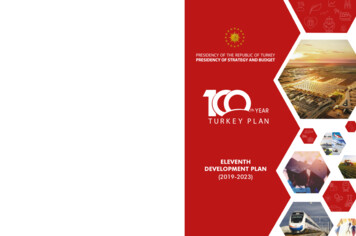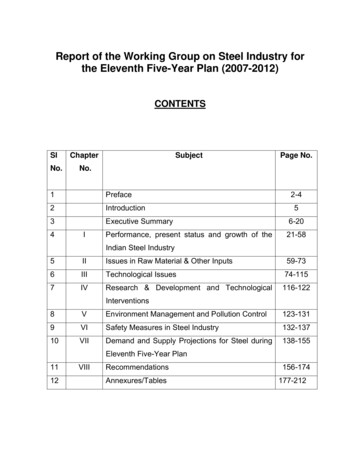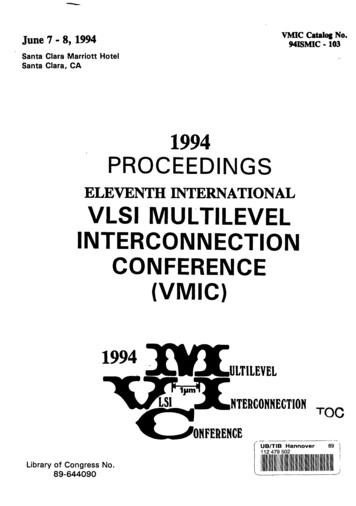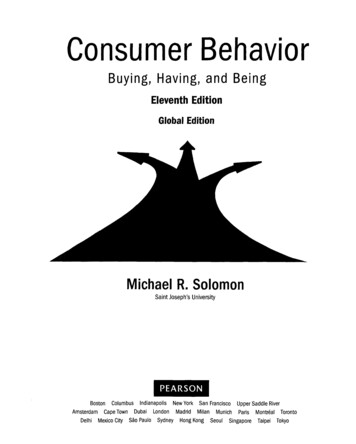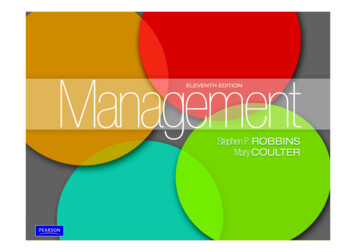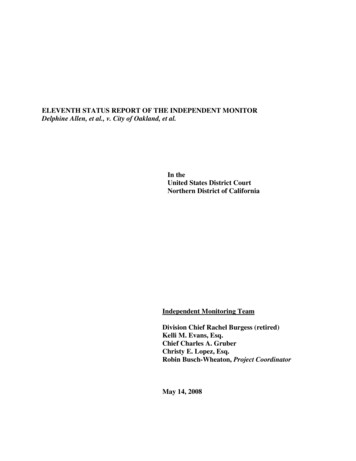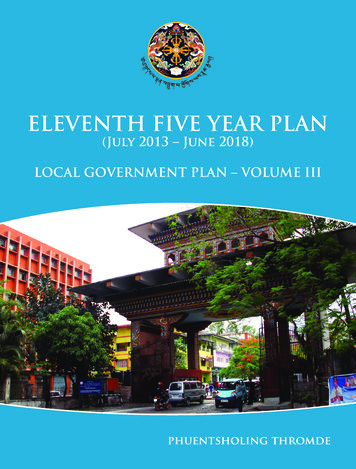
Transcription
Eleventh Five Year Plan - Phuentsholing ThromdeELEVENTH FIVE YEAR PLAN(July 2013 – June 2018)LOCAL GOVERNMENT PLAN – VOLUME IIIELEVENTH FIVE YEARPLAN1st July 2013 – 30th June 2018MAIN DOCUMENT – VOLUME 1Gross National Happiness Commission, Royal Government of Bhutaniphuentsholing thromde
Eleventh Five Year Plan - Phuentsholing ThromdeEleventh Five Year Plan Document Copyright Gross National Happiness Commission (2013)Published by: Gross National Happiness Commission, Royal Government of Bhutan.ISBN 978-99936-55-01-5ii
Eleventh Five Year Plan - Phuentsholing ThromdeHIS MAJESTY THE KING JIGME KHESAR NAMGYEL WANGCHUCKiii
Eleventh Five Year Plan - Phuentsholing Thromdeiv
Eleventh Five Year Plan - Phuentsholing ThromdeOur Nation has seen great socio-economic growth but it is more importantthat we have growth with equity. We must raise, with all our effort, the lessfortunate so that they may, at the earliest, begin to partake in the opportunitiesbrought by modernization and progress.The government has provided education to our youth. But for the nation toprosper for all time, a sound education must be succeeded by access to the rightjobs and responsibilities, so that our youth may bloom as individuals and at thesame time serve their Nation well.The recent Rupee shortage is a serious problem. I feel it is a reminder that, as aNation, we must exercise our traditional sense of caution and work even harderas we address the challenges of the time. For no matter what challenges lieahead, it is only the Bhutanese citizen who can protect and safeguard Bhutan.- His Majesty The King’s address to the nation during the 105th National Daycelebrations, 17th December 2012, in Thimphu.v
Eleventh Five Year Plan - Phuentsholing Thromdevi
Eleventh Five Year Plan - Phuentsholing ��ཞུང་།Royal Government of BhutanPRIME MINISTERvii
Eleventh Five Year Plan - Phuentsholing ��ཞུང་།Royal Government of BhutanPRIME MINISTERviii
Eleventh Five Year Plan - Phuentsholing ��ཞུང་།Royal Government of BhutanPRIME MINISTERix
Eleventh Five Year Plan - Phuentsholing Thromdex
Eleventh Five Year Plan - Phuentsholing ThromdeTABLE OF CONTENTS1.INTRODUCTION.11.1Planning Process.41.2Resource Allocation Formula.41.3Capital Allocation.52.PHUENTSHOLING THROMDE PLAN.52.1Current Situation.52.2Key Opportunities/Challenges.62.3Strategies.62.4 Thromde Key Results Area.82.5Results Matrix of Thromde Plan.102.6Thromde Education Plan.173.ANNEXURE.213.1Structural Plan.213.2Local Area Plan.22xi
Eleventh Five Year Plan - Phuentsholing Thromdexii
Eleventh Five Year Plan - Phuentsholing Thromde1.IntroductionThe bottom-up Gewog-based planning process, as per the decentralized planningframework, was introduced in the Ninth Plan. Since then, the local governmentshave been formulating their Five Year Plans based on the development prioritiesidentified by the communities at the Gewog level.The introduction of the Gewog-based planning process was followed by “fiscaldecentralization” in the Tenth Plan. The allocation of annual grants to localgovernments based on the resource allocation formula that took into accountprinciples of equity, transparency and objectivity was launched. The new systemof allocating resources to the local governments provided greater predictabilityand offered higher flexibility in prioritization and programming of activities. Thedevolution of authority has enhanced capacities of the local governments inplanning, prioritization and fiscal management.Further, to bring clarity on the roles of various levels of the government in thedelivery of public services at the local level and to facilitate the distributionof resources between the centre and the local governments, the division ofresponsibilities framework was developed in 2012. The division of responsibilitiesframework1, clearly delineates responsibilities among the central agencies, Class“A” Thromde, Dzongkhags and Gewogs guided by the ‘principle of subsidiarity’.The ‘principle of subsidiarity’ is that provision of public goods and services shouldtake place at the lowest level of the government and that the centre should beinvolved only when the lower levels of the government cannot provide the goodsand services efficiently. The division of responsibility framework will be reviewedduring the Eleventh Plan mainly to assess the capacity of the local governments toshoulder increased responsibilities and to build their capacities accordingly.In addition to the broad based socio-economic development activities, targeted povertyintervention programmes such as the Rural Economy Advancement Programme (REAP)and the National Rehabilitation Programme (NRP) were initiated in the Tenth Plan toaccelerate poverty reduction and address disparities at the local level. Accordingly, 13poorest villages2 were supported through REAP I and around 109 villages have beenidentified for implementation under REAP II in the Eleventh Plan.Refer okha, Dramekha and Ngatsena - Haa, Sanu Dungtoe - Samtse, Mandokha & Choleykha Chukha, Lopokha - Wangdue Phodrang, Lauri - Samdrup Jongkhar, Ungar - Lhuentse, Samcholing- Trongsa, Reti - Sarpang, Lamtang - Zhemgang, Pam & Chaibi - Mongar.121
Eleventh Five Year Plan - Phuentsholing ThromdeUnder the NRP, 44 households in Khenadrang, Pemagatshel were rehabilitated.While the rehabilitation at Nye, Lhuentshe (55 households); Bebji, Haa (83households); Borangmo, Pemagatshel (51 households) and Dawathang, SamdrupJongkhar (31 households) are ongoing, the planning and feasibility study forTanzama, Pemagatshel and Serzhong, Tsirang respectively have been initiatedunder the programme. Efforts are also underway to identify other communitiesfor rehabilitation given that this programme benefits not only the beneficiarycommunities but also the government through avoidance of the higher costsassociated with provision of pubic goods and services for reaching the unreached.1.1Planning ProcessThe local government plans were formulated based on the Local Government Act2009, the Eleventh Plan preparation guidelines, the Local Development PlanningManual, the Thromde Structural Plans, the Local Area Plans (LAPs) and theindicative five year resource envelope. The process involved close consultationswith the communities in order to take stock of the ground realities and assess theirneeds and aspirations. These were further deliberated and discussed at the GewogTshogdes, Dzongkhag Tshogdus, and Thromde Tshogdus before being finalized andapproved. The draft LG Eleventh Plan was then submitted to the GNHC for furtherdiscussion and coordination at the national level.While sectoral activities at the local level, as per the division of responsibilityframework, are prioritized and planned by the local governments, the planning foreducation activities is centrally coordinated by the Ministry of Education. This isdone given the strategic importance of the education sector for the future of ournation and to ensure that all children across the nation have equal access to quality,adequate, efficient and cost effective education services. The implementationis done by the local governments with resources provided by the Ministry ofEducation.1.2Resource Allocation FormulaCriteria for Resource Allocation FormulaSl. No.1.2.CriteriaPopulationPoverty10th PlanFormula70 %25 %Revised NewFormula35 %0%2
Eleventh Five Year Plan - Phuentsholing Thromde3.4.5.AreaMultidimensional Poverty Index3 (MPI)Transport Cost Index4 (TCI)5%-10 %45 %10 %The major changes in the formula in the Eleventh Plan are that allocation forpopulation has been reduced from 70 percent to 35 percent, area has beenincreased from 5 percent to 10 percent, poverty criteria has been replaced bymultidimensional poverty index with a weight of 45 percent and a new criteriaon transport cost index with a weight of 10 percent has been included to accountfor high cost of investments in interior and remote Dzongkhags/Gewogs that facehigher transportation costs.The formula based resource allocation does not apply to class “A” Thromdes. Theresource allocation to class “A” Thromde are need based due to the diversity andcomplexity of these Thromdes in terms of social, economic and environmentalissues. Further, while some Thromdes are ready with their structural plans and thelocal area plans, which form the basis for infrastructure planning and investments,others are still in the process of preparation.1.3Capital AllocationFrom the total capital budget of Nu. 92 billion, Nu. 25 billion (about 27 percent ofthe total) is allocated to Local Governments as follows: Formula based annual grants to the Dzongkhags and Gewogs - Nu. 15 billiono Of which to Dzongkhag –o Of which to Gewogs –Nu. 9 billion (60 percent)Nu. 6 billion (40 percent) Local Government Empowerment Programme(Dzongkhags and Gewogs )-Nu. 5 billion Capital grants to class “A” Thromdes (Thimphu, Phuentsholing,Gelephu and Samdrup Jongkhar) -Nu. 5 billionTotalNu. 25 billionIncome, Life Expectancy and Education IndexRatio of distance (kms) from the nearest markets (P/ling, S/Jongkhar, G/phu)343
Eleventh Five Year Plan - Phuentsholing ThromdeThe formula based annual grant of Nu. 15 billion to the local governments in theEleventh Plan is 25 percent increase over Tenth Plan allocation of Nu. 12 billion.Nu. 5 billion under Local Government Empowerment Programme is for commonfacilities such as utility vehicles, power tillers, and Nu. 2 million per Gewog peryear.For the four Thromdes (Thimphu, Phuentsholing, Gelephu and Samdrup Jongkhar)an allocation of Nu. 5 billion is earmarked for municipal infrastructure and services.In addition to Nu.25 billion directly earmarked for allocation to the LocalGovernments, a provision of Nu.4.5 billion is kept under Ministry of Education forDzongkhag Education Services which will be implemented and benefit the localgovernments. Moreover, the activities implemented under the Targeted PovertyInterventions programmes will be over the above the local government allocation.The capital grants allocation in the Eleventh Five Year Plan for PhuntsholingThromde:Sl. No12ThromdePhuntsholing ThromdeThromde EducationTotal11 FYP Indicative Capital Allocation(Nu in millions )1020.342113.1841134.8424
Eleventh Five Year Plan - Phuentsholing Thromde2.Phuentsholing Thromde PlanPhuentsholing, under Chukha Dzongkhag, is the main gateway to Bhutan and as aresult, it has become the biggest commercial and industrial hub of the country. Itis located at the south western foothills of the country bordering the Indian stateof West Bengal. The town is located near the Amochu and Omchhu river banks.Phuentsholing Thromde has six demkhongs with a population of 24,000 and anarea of 19.68 sq km.In line with the Local Government Act 2009, Phuentsholing Thromde is a selfgoverning municipality with an elected Mayor, Thromde Thuemis and a ThromdeCouncil in place since January 2011.2.1Current SituationPopulationArea (sqkm)Number of DemkhongsAccess to improved water source(BLSS 2012)ANER (basic)-m/f (BLSS 2012)24,000 Access to improved sanitation facility (BLSS 2012)19.697.6(95.5)Child survival rate (BLSS 2012)97.00(96.9)6 Adult Literacy Rate (BLSS 2012)63.3(55.3)99.6(99.3) ANER (Pry)-m/f (BLSS 2012) 94.1 (95.2)84.4 (88)(Figures in the bracket represent National average/total.)With some of the large mineral, metal and wood based industries located inPasakha, Phuentsholing is one of the major industrial hubs of the country. It isalso a major trading hub due to its close proximity to the Indian towns of Siliguriand Jaigoan. The town also has a well established network of financial and socialinstitutions,business enterprises, whole sale traders, training institutions andcollege of science and technology attracting people, goods and services.There are two industrial estates in Phuentsholing. The Phuentsholing IndustrialEstate has an area of 61 acres, including one acre near Doti khola, and housesmore than 15 industrial sheds. The Pasakha Industrial Estate is located 16 km eastof Phuentsholing in an area of 267 acres. The industrial estate is connected with allfacilities like road network, water supply, power and transmission lines, drainagesystems, telecommunication facilities and estate management office.5
Eleventh Five Year Plan - Phuentsholing Thromde2.2Key Opportunities/ChallengesPhuentsholing is a major industrial and trading hub of the country. The opportunitiesoffered by Phuentsholing are expected to be further enhanced with a numberof new activities planned in the coming years. The major activities include thecompletion of Samtse-Phuentsholing highway; establishment of a mini Dry Port,Warehousing & Distribution Complex in Phuntsholing; construction of three newmega hydroelectricity projects viz. 180 MW Bunakha Hydroelectric project, 540MW Ammochhu Hydroelectric project, and 570 MW Wangchu Hydroelectricproject, and Amochu land reclamation project.While such developments are received positively, the major challenge for theThromde is the capacity and the resources to provide basic planned urbanfacilities and services to the rapidly growing urban population. After Thimphu,Phuentsholing receives the highest number of inward migration as a result ofwhich the town is growing at the rate of 3 percent per annum. Already, the existingurban infrastructure facilities and services are under tremendous pressure. Theissues of housing shortage, lack of clean and reliable drinking water, solid wastemanagement problems, traffic congestion, environmental issues, security andsafety issues, and poor urban infrastructure are major concerns. Some of thePhuentsholing residents are forced to live across the border due to housingshortages.2.3StrategiesIn keeping with the Eleventh Plan objective of ‘Self-reliance and Inclusive GreenSocio-Economic Development’, Phuentsholing Thromde will aim to develop aneconomically vibrant, ecologically sustainable and energy efficient town, theobjective of the Thromde is to make Phuentsholing Town a ‘Clean, Green andLivable Town’.The strategies towards this are: Phuentsholing Thromde will prepare and finalize local area plans forPekarshing, Malbasy and Gurungdara to ensure planned and sustainabledevelopment of these areas. The shortage of drinking water will be addressed by exploring andconstructing bore wells, ground-water, and reservoir schemes. Sewerageand waste management system will be constructed and improved.6
Eleventh Five Year Plan - Phuentsholing Thromde Thromde will construct Thromde office, and construct new urban roadsin Kabreytar, Pasakha, Pekarshing, Damdara, Core area, implementRinchending LAPs, and motor able bridge over Omchhu. To enhance safety, promote community vitality and make Phuentsholinga highly livable town, street lights, CCTVs, bicycle paths, footpaths,recreational parks and sports facilities will be constructed. To address the issues of housing shortage, National Housing DevelopmentCorporation in close collaboration with the Dzongkhag and Thromde willconstruct an additional 250-300 housing units over the next five years. To improve quality, adequacy and effectiveness of education and learningand improve students’ intake, existing school infrastructures, facilities andcapacity will be improved and new infrastructures and additional capacitywill be built and strengthened.7
Sector Key Result AreasKey Performance Indicators(Outcome)Thromde Key Result AreasBaselineIncreased access toaffordable and qualityeducationSustainableand EquitableSocioA sustainable, safe,Economicreliable, affordable andDevelopment green public transport inthe citySocio-economicinfrastructure andfacilities are improvedand adequate, enhancingthe service capability,safety and aestheticbeauty of the city1) 42) NA1. Frequency of publictransport (in hours)2. Ridership of publictransport (%)3. % of population livingwithin 500 metres of publictransport route4. No. of public transportservices with facilities forsenior citizens, women,children and those withspecial needs1) 94.11. Primary enrolment rate (% (M/F)ANER/F)2) 1:242. Teacher : pupil ratio (2012AES)4) 03) 501)NA2) NA3) NA4) 01) Livability Index of Class AThromdes2) Disability, elderly, childrenand gender responsiveinfrastructure3) Pedestrian pathway (Km)4) Incidences of waterlogging/flooding (no)Key Objective:- Clean, efficient and sustainable commercial hub in the countryGNH Pillars2.4Key Interventions1) 100(M/F)2) 1:24Provision of affordable and qualityeducation infrastructure andservices1) Track2) 703) 54) 81. Provision of safe and adequatesocio-economic infrastructure2. Provision of infrastructure forclean, safe and reliable drinkingwater and sanitation3.Explore alternate source of1) 1water - groundwater, rainwater2) 70harvesting etc.3) 100 4. Development/identificationof service facilities based onconstituencies (suburb ideas)4) 45. Provision of better, green,affordable, reliable and safe publictransport systemsTarget8Eleventh Five Year Plan - Phuentsholing ThromdeEleventh Five Year Plan - Phuentsholing Thromde8
StrengtheningGoodGovernance4) 905)All6) 451) 354) 605) 66) 401. TAT reduced for core1) 45public services in minutes2. Efficiency in addressing2) 50customer complaints (%)3. Disaster response time3) 2(Hours)1. Crime incidence againstpersons and properties (no)2. Perception of safety bycity dwellers3. No. of abuse of drugs andvicesEffective and efficientpublic service deliveryPublic safety, peace andorder assured at all times2) NA3) 121) 233) 703) 202) Verysafe3) 51) 103) 12) 902) 152) 15Solid and liquid wastesgenerated in the city areminimized and properlymanaged, cleanliness andsanitation are maintainedat all timesConservation& SustainableUtilizationandManagementofEnvironment1) 801) 301. Awareness and knowledgeof segregation 3Rs. (%)2. Amount of solid wastegenerated (MT/day)3. Extent of solid wasterecycled (%)4. % of householdsconnected to seweragesystem5. No of functional andgender friendly public toilets6. % of green Thromde Areas1) 1002) High1) 902) NA1) % of buildings,infrastructure withtraditional designs2) Community vitality indexBhutanese identity andculture strengthened.PreservationandPromotion ofCulture1. Automate G2C, G2B, G2Gservices.2. Implementation of GPMS/Agencification.3. Outsourcing/cost sharing ofsome functions.1. Provision for bicycle paths/pedestrian walkways, children’spark/recreational/sports facilitiesetc.2. Eco-efficient infrastructure(street lights, water and sanitation,special needs, etc.)1. Incorporate Bhutanese architectetc into municipal infrastructure.9Eleventh Five Year Plan - Phuentsholing ThromdeEleventh Five Year Plan - Phuentsholing Thromde9
8NAIncidences of water logging/flooding (No)% of recurrent expenditure met from internalrevenueOutcome 004 : Health status, access tohealth facilities and overall wellbeing ofthe residents are improvedOutcome 003 : Increase access toaffordable and quality education624566Mortality (Incidences)Morbidity Incidences)Life expectancy95%Students performance against the nationalaverage01:32Teacher : pupil ratioImproved nutritional status of children (1-12years)98%NAPrimary enrolment rate% of household living within 500 metres ofpublic transport routeTwice adayNAPedestrianization of city (kms)Frequency of public transport (In a day)NADisability, elderly, children and genderresponsive infrastructure (%)Outcome 002 : A sustainable, safe,reliable, affordable and green publictransport in the cityNALivability Index of Class A ThromdesOutcome 001 : Improved quality of 01220122012201295 5 100100%1:25100%604 times aday 700570%HighBaselines Base Year Plan TargetsIndicatorsResults Level (Outcome)Table 1: Programme Results Level2.5 Results Matrix of Thromde Plans10Eleventh Five Year Plan - Phuentsholing ThromdeEleventh Five Year Plan - Phuentsholing Thromde10
Outcome 008 : Public safety, peace andorder assured at all timesOutcome 007 : Effective and efficientpublic service deliveryOutcome 006 : Solid and liquid wastesgenerated in the city are minimizedand properly managed, cleanliness andsanitation are maintained at all timesOutcome 005: Bhutanese identity,tradition and culture strengthened.60NA% of households connected to sewerage system% of green Thromde Areas23NA12NAPerception of safety by city dwellersNumber of abuse of drugs and vices% of urban population feeling safe to live, workand travel anytime in the town2 HoursCrime incidence against persons and propertiesDisaster response time50%6Number of functional and gender friendly publictoiletsEfficiency in redressal of customer complaints20Extent of solid waste recycled (%)4515Amount of solid waste generated (MT/day)TAT reduced for core public services (no of days)30NACommunity vitality indexPercentage of household with awareness andknowledge of segregation 3Rs.9060% of buildings, infrastructure with traditionaldesigns% of households with access to safe, clean andreliable drinking water and 201220122012201220122012 90 5Very safe 10 1 Hour90%354590All601580High10098 11Eleventh Five Year Plan - Phuentsholing ThromdeEleventh Five Year Plan - Phuentsholing Thromde11
54040Number of urban infrastructure maintainedKms of urban drainage/road/footpath/sewerageconstructedKms of urban drainage / road / footpath /sewerage maintainedOutput 005:Improved social andcommunity cohesivenessOutput 004: Improved health facilities,Status and wellbeingOutput 003:Improved Educationinfrastructures and Facilities35Facilities for cultural and spiritual pursuitsNumber of voluntary activities undertaken60%0Number of Up-gradation of existing facilitiesImproved water Supply and sanitation01Number of NFE centersNumber of new health facilities0Number of Up-gradation10Number of new schoolsFunctional health facilities and infrastructures inplace9130%Functional Education facilities andinfrastructures in placeIntroduced public transportCreated awareness on the use of public transport15Number of new urban infrastructure constructedIdentified public transport routes and stops3Number of local area plan preparedOutput 002: Introduced safe, green andreliable public transport system1Structural plan preparedOutput 001: Improved Thromdeinfrastructure and facilitiesBaselineIndicatorsResults Levels 0%410050151031Base Year Plan Targets12Eleventh Five Year Plan - Phuentsholing ThromdeEleventh Five Year Plan - Phuentsholing Thromde12
Output 008: Enhanced street lighting andCCTV systemsOutput 007: Established and improvedpublic services counterOutput 006: Improved water, waste andsanitation system00Number of trained and functional disaster unitNumber of disaster volunteer team in eachurban DemkhongFunctional CCTV in designated areas07300% of urban population using e-governance forservicesFunctional street lighting in designated areas05Number of improper dumping siteAdoption of e-governance for public services50% of households connected to sewerage system11Treatment of waste waterNumber of functional one stop shops750%Percentage of households who know theirneighborsFunctional water, waste and sanitation systemsin place60%0Strict compliance and monitoringNumber of community gathering 20122012201210100061501208041280%95%113Eleventh Five Year Plan - Phuentsholing ThromdeEleventh Five Year Plan - Phuentsholing Thromde13
20.0001.00010.00031.000Local Area Plan preprationDevelopment of Thromde infrastructuresConstruction of City Office (Thromde office)Construction of international gatesHousing for National Work ForceConstruction of Vegetable MarketDevelopment and improvement of road networksConstruction of new urban roadsRoad ResurfacingMaintenance of Roads & BridgesSewerage and waste managementConstruction of waste water treatment plantsPreparation of sewerage network & solid wastemaster planMaintenance of sewerage systemConstruction and improvement of drainagesystem and footpathConstruction of Storm water 00Structural plan preparation17.000Local Area PlanPlan Outlay(in Million)ASl.No Activity and Sub-activitiesCore / Extended areaDamdara/ /Rinchending LAPsLower market (core)Below STPCore area & PasakhaCore areaPekarshing/Malbasy/GurungdaraWhole Thromde jurisdictionLocation3 km2 Nos21 Km21 Km20 km30 units2 nos.Fund earmarked forCity office and basement parking onlyRemarks14Eleventh Five Year Plan - Phuentsholing ThromdeEleventh Five Year Plan - Phuentsholing Thromde14
Construction and improvement of Thromde watersupply & sanitationPreparation of water supply master planConstruction of water supply schemesAugmentation and rehabilitation of water supplyConstruction of gender-friendly public toiletsConstruction of vehicle parkingsConstruction of Multi-Storey car parkingConstruction of off - road public parkingsStrengthening of Thromde Institutional CapacityPurchase of Furnitures, Equipment & MachineriesSet up of GISDevelopment of land information systemConstruction of service countersConstruction and improvement of bridgesConstruction of motorable BridgesF1234G12H1234I1Construction of pedestrian bridges33.000Improvement of existing footpath525.000Construction of Foot Improvement of existing storm water drains31.000Preparation of storm water drainage master plan2DPNB Junction/Datshang/PemalingOver OmchhuNear NPPFPekharshing/damdara/pasakha/CoreCore / Extended area3 nos.1 Permanent bridge(Nu. 90 M) and 1 Bailey bridge (Nu. 5 M)1 no.PPP Model3 Km15Eleventh Five Year Plan - Phuentsholing ThromdeEleventh Five Year Plan - Phuentsholing Thromde15
15.000Awareness programDevelopment of parks and recreational facilitiesConstruction recreational parksPlantation & Sanitation awareness programDevelopment of public transport systemConstruction of bus stopsConstruction of bus terminalsInstallation and maintenance of street lightingand CCTVsConstruction of street lightsInstallation of CCTVCultural and community development programsConstruction of Community centresCommunity vitality programme and awareness3K12L12M12N12Total for Thromde1.000River training/ Flood 2.5002.0003.0005.0001.00010.00010.000Slide mitigation121.000Disaster management and risk reductionJDamdara/Kabreytar/Rinchending/Pekarshing & ChamgmariCoreExtended AreaCoreDamdara, kabreytar,Pasakha,Pakershing,Rinchending, CoreExtended Area & CoreExtended area & OmchuExtended area /core5 Nos100 Nos1 Nos6 Nos1000 Saplings3 Nos2 Km5 Location16Eleventh Five Year Plan - Phuentsholing ThromdeEleventh Five Year Plan - Phuentsholing Thromde16
School enrolment enhancedResult level(Outcome)Learning outcomes of studentsenhanced171760% for Dzongkha70% for othersubjects90%Class III:Eng: 94.2%Math:93%Dzongkha:93.1%EVS::92.96%Learning Outcomes Scores inMath,English, Dzongkha andScience in class III, VI, X, XII (m/f)Class VI:Eng: 49.2%Math:46.1 %Dzongkha: 47%Science: 43.6%100%83%90%Not availableNumber of schools with SchoolDisaster Mgt Plans (SDMPs)00100Number of new schoolsestablished00084.4 (82-m; 87.2f): BLSS 2012ANER (basic)-m/fNumber of new ECRs established95% (m/f)94.1 (94.9-m;93.4- f) :BLSS2012ANER (Pry)-m/f95% (m/f)TargetBaselineIndicatorsEducation facilities expandedNumber of schools upgradedResult level (Output) or rationalized with a safe andconducive learning environment Number of schools downgraded% of schools meeting safetystandardsResult level(Outcome)RESULTSDzongkhag/Thromdey Key Result Areas2.6 Thromde Education PlanEleventh Five Year Plan - Phuentsholing ThromdeEleventh Five Year Plan - Phuentsholing Thromde
Learning outcomes of studentsenhancedValue based education andResult level (Output) environmental educationstrengthened in schoolsSchools equipped with ICTResult level (Output) infrastructure and internetconnectivitySchools have adequate teachersand appropriate supportResult level (Output)services to enhance teachermotivation and performanceResult level(Outcome)90%% of students who can perform atleast two traditional dance and songs80%% of schools with internetconnectivityNot available100%% of schools with computer facilities% of schools with traditional artsand crafts clubsNot applicable% of teachers with access to staffquarters in remote schools80%3No of Teacher Resource Centres% of schools above 70 on GNHindexNot available% of teachers availing PD as perINSET Master Plan100%30%100%100%100%Not applicable210%18Teacher-pupil ratio2.95%1:24 (2012 AE
ELEVENTH FIVE YEAR PLAN 1st July 2013 - 30th June 2018 MAIN DOCUMENT - VOLUME 1 Gross National Happiness Commission, Royal Government of Bhutan . With some of the large mineral, metal and wood based industries located in Pasakha, Phuentsholing is one of the major industrial hubs of the country. It is
